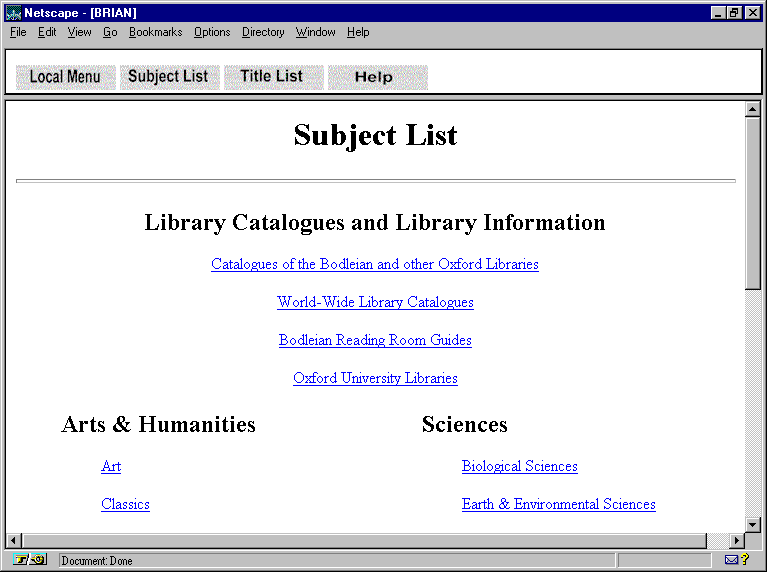Down Your Way: The Radcliffe Science Library
Filled with awe at the prospect of meeting the bearer of the weighty title Deputy Keeper of the Scientific Book, I journeyed to the Radcliffe Science Library in Oxford to meet Dave Price. Dave is also Head of Systems and, wearing this hat, was keen to show me the work that has been done to advance a range of electronic information services.
The Radcliffe Science Library is one of seven libraries attached to the Bodleian Library, the largest academic library in Europe. As the science department of the Bodleian and one of the legal deposit libraries, the Radcliffe Science Library receives a free copy of all British scientific publications and houses some 6 million books. There are especially strong collections of older materials, and a unique collection of manuscripts. The Bodleian is, however, very advanced in terms of Information Technology, and had the first library WWW server in the world. Via the library website, BARD (Bodleian Access to Remote Databases) has provided a gateway to networked information services around the World, and there are many impressive online reader guides to using the libraries, a number of which are in Adobe Acrobat (PDF) format. Again using Acrobat, the Bodleian is keen to promote and facilitate the use of electronic journals. The Library is anxious that they are a success with users. There are also a number of ongoing digitised imaging projects. With so many electronic library initiatives going on in the Library, Dave focused on two particularly innovative projects: BRIAN and the Mobile Computing Service.

To optimise user access to expensive information sources, the Bibliographic Resources Interface for Accessing Networks (BRIAN) has been developed. BRIAN integrates around 200 quality bibliographic reference databases (for which the university pays a subscription fee) that are made available on campus. These electronic resources use a range of technologies like telnet, proprietary software and WWW and often require usernames. Through a simple interface, BRIAN integrates these disparate services as far as possible and provides guidance in their usage. The start up page provides a subject breakdown of all the information sources; this pragmatic classification matches to a certain extent the workings of the university. By clicking on any option from the hypertext menu, the user is given a list of the available sources together with a brief annotation. Having selected a source, the user sees a full description and any necessary technical information, such as registration details. Finally, the user connects to the service, launching the appropriate programme to access it. A script will automatically insert the username and password, a big help when you consider that some users need to remember up to 20 different passwords!
BRIAN is a configurable Windows 95/ Windows NT application, which only took 8 hours of programming. It is fundamentally a homegrown WWW browser providing the necessary navigation system for people to use information sources easily. The content of this system is html, and so it could be maintained by a subject librarian, not the Systems section.
Dave admits that the system is not perfect; indeed he talks about the limitations of what can be achieved at present in a recent paper at the 63rd IFLA General Conference [1].
Many of the faults lie with the suppliers of the database products. However, this WWW-based solution frees users from having to know about technology before they look at a source. A WWW version of BRIAN can be viewed at http://www.bodley.ox.ac.uk/brian/ using a normal Web browser.


The Dearing report predicts that students will be required to supply their own personal computers in a few years’ time. For the incoming students of the new School of Business Management at Oxford, this is already the reality. This increased demand for users to plug their portables into the library network has driven the pilot Mobile Computing Service. Learners are able to temporarily turn their portable PCs into reader workstations by using dynamic allocation of IP addresses, and then installing BRIAN. The problems of weak Internet protocol and security of the network have been overcome by setting up a cross-campus central server. Users need to know their ethernet card number, so that they can register to use their portable within certain units across the university. If the user is not registered to access the network from a particular department or unit, permission will be denied when they try to connect their PC to an Ethernet socket. If the system is abused, the IP address can always be traced to an individual.
Study space is a problem at Oxford, and there are few resources available to create more areas with user workstations. At Oxford and at other institutions, initiatives of this kind will undoubtedly become increasingly important.
More information on the project can be found at: http://www.bodley.ox.ac.uk/mobile/.
So, far from guarding library resources under lock and key, Dave and his colleagues at the Radcliffe Science Library are unleashing a range of information sources for cross-campus users.
References
[1] 63rd IFLA General Conference
http://www.bodley.ox.ac.uk/djp/ifla97.htm
Author details
Sarah Ashton is NetLinkSResearcher and Information Officer
Dept of Information Studies,
University of Sheffield
Western Bank, Sheffield S10 2TN
s.j.ashton@sheffield.ac.uk
